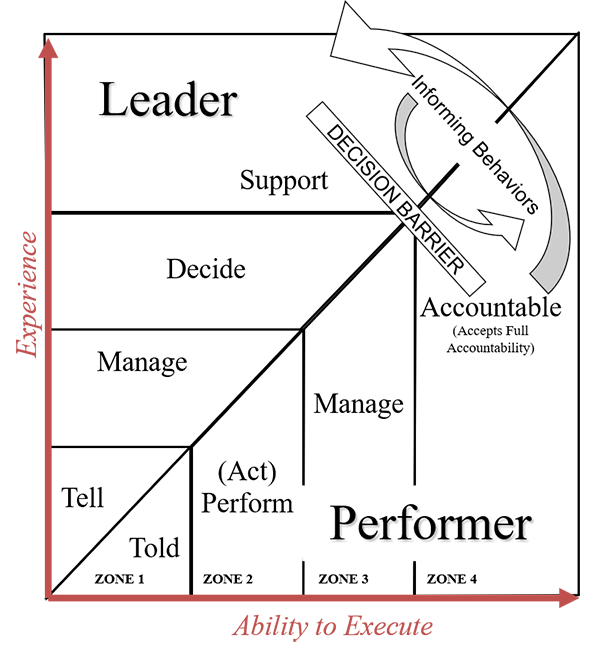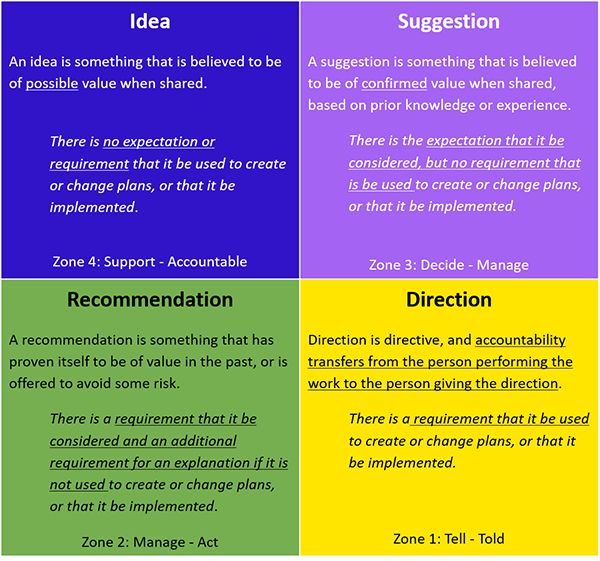Date Published February 8, 2018 - Last Updated April 19, 2019
Technical support and service leaders do not have to struggle with the opposing forces of aligning their organization and empowering their teams. Individual contributors can resolve their frustration with the lack of autonomy in the age of accountability. With a simple framework and two easy-to-employ techniques, teams and organizations will find themselves in the enviable position of gaining everyone’s best contributions towards a set of agreed-upon goals.
The empowerment framework in this article provides a vocabulary for situational role clarity. This role clarity is further enhanced by a progressive hierarchy of leadership activities and a proven technique for gaining rock-solid alignment while promoting empowerment.
Can autonomy produce aligned results, or are leaders forced to use command and control?
When I worked for Whole Foods Market as an IT director, the company was experiencing significant growth while maintaining a regional and store autonomy principle that was fairly unique in the retail industry. This was a commitment so deep the company’s corporate offices were referred to as the “Central Region,” as opposed to “headquarters,” to evoke our equality with each region.
At the time, autonomy within the retail industry was more often viewed as something to ruthlessly eliminate. As an example, numerous published reports spoke of the internal cost controls employed by retail giant Walmart, citing examples of the thermostats in every Walmart store being controlled from their headquarters in Bentonville, Arkansas.
In spite of the prevailing so-called “retail industry best practices” that emphasized rigorous centralized control, Whole Foods Market achieved profitable growth by combining empowered team members with reduced ambiguity about measuring results. Throughout the rest my career, empowerment and reducing ambiguity about results have been two key leadership capabilities that produced great results.
The empowerment framework in this article was frequently used by Mike Clifford, Vice President and CIO of Whole Foods Market and those of us on his senior leadership team. He recalls that he first saw the framework “in a Harvard Business Review article from a long time ago.” I’ve searched for, but have been unable to find, the original article. I also presented this framework in an HDI Conference and & Expo session several years ago.
How to Use a Framework for Empowerment
The framework for empowerment we used contains a series of activities performed by one of two roles: Leader and Performer. The Leader’s activities progress along a vertical axis that indicates the Leader’s capabilities growing with leadership experience. The Performer’s activities progress along a horizontal axis that indicates capabilities growing with the ability to execute. Each activity for the respective roles forms a pair of corresponding activities that describe the relationship, or work-style, employed in a given situation. For easy reference, these relationships or work-styles are designated as “empowerment zones.”

Once the Leader and Performer understand this framework, it can be used as a common vocabulary to establish situational role clarity. For example:
-
“This project has many dependencies on other departments. I need you to manage it from Zone 3 while I provide air cover.”
-
“This is our first major infrastructure upgrade project, and there is a lot of visibility to it. I need to lead this from Zone 2 at least until we get some milestones behind us.”
In both of these examples, the Leader is communicating to the Performer the project-specific roles each of them will take on, and what kinds of activities they will each be responsible for. In Zone 3 (Decide-Manage), the Leader is making decisions, and the Performer is managing actions to implement those decisions. In Zone 2 (Manage-Act), the Performer is acting in a more task-oriented mode.
Part of the conversation about empowerment is the concept of accountability. Some of the components of accountability like autonomy, discretion, and decision-making are directly related to the level of engagement or internal commitment that employees have towards their company. Therefore, successfully leveraging this framework can lead to more engagement and higher performance and job satisfaction for employees.
Frequently, a “decision barrier” exists between Zone 3 and Zone 4 that stands in the way of a Performer being fully accountable in a given situation. This decision barrier can be imposed by the Leader or by the Performer, and is often imposed unintentionally or subconsciously. Many times, the decision barrier is caused by a lack of sufficient “informing” behaviors, in both directions, so that the Leader can provide support to the Performer. This concept can be used to improve alignment between the Leader and the Performer roles, for example:
-
“I feel like a decision barrier is forcing me to come back to you too often. How can we improve my informing behaviors so that I can take full accountability?”
Command and control (Zone 1: Tell-Told) is a sign of corrective action, and the goal should be to get back to a higher empowerment zone. It is almost always a sign of failure, and it is almost never sustainable.
Words that Help Reduce Ambiguity
I had an eye-opening experience about ambiguity in my first few weeks in a new leadership role at a new company. I had saved a document containing some pre-interview thoughts about process improvements to my team’s shared storage area. I had created that document during my preparation for the interview process for that role, and it contained generic examples of hypothetical process improvements for incident and problem management. Despite me having forgotten about the document, some six weeks later my help desk supervisor informed me that he had implemented the process improvements directed by that document, which I had created before I was even employed! Fortunately, they were good improvements, but ambiguity strikes again!
We had a good laugh about it and then had a serious discussion about reducing ambiguity as a leader. As an enhancement to the empowerment framework, we had a set of “anti-ambiguity” words that we used to be absolutely clear about the guidance we were giving as leaders: idea, suggestion, recommendation, and direction. Here is how they are used:

Idea is the term to use when you want to make sure something is being considered, but are not insisting or dictating that the idea be followed. Whatever the course of action or train of thought is, it is probably just another way to do something, and it is likely that other stakeholders may ask if it has been considered. It might also help redefine what limits there are on solving a certain problem or accomplishing a certain goal. It most likely will spark more discussion, which is good.
Suggestion is the term to use when you really want something done, or done a certain way, but are open to other ways of doing it if that other way accomplishes the same goal. There is usually a purpose behind a suggestion (i.e. to address a concern or gap you have recognized, to avoid a risk that has a high likelihood of occurrence or large impact, to integrate what's being done with other activities, etc.).
Here is a little trick I’ve used successfully: when my leader makes a suggestion or recommendation that I don't agree with, instead of saying "you don't know what you're talking about" or "here's all the reasons why that won't work," I always say "why are you suggesting/recommending we do that?". It usually leads to the concern, gap, risk, or integration point, and if the suggestion doesn't fit with my preferences, I can usually come up with a way to accomplish the same goal in a way that does fit with my preferences. Suggestions should also spark more discussion, I think, if the real goal of the suggestion hasn't been exposed.
Recommendation is the term to use when you really want something done, or done a certain way, and are only open to other ways of doing it after being convinced that the recommendation won't work. Like a suggestion, there's usually a purpose behind a recommendation, but it's usually pretty obvious and, to the person making the recommendation, not necessarily negotiable. Using the word recommendation is a way of letting someone know that you'll be holding them accountable for successfully satisfying the purpose behind the recommendation. They would have to explain why they didn't follow a recommendation and know that there would be consequences. Most discussions sparked by recommendations are shorter than the discussions sparked by ideas or suggestions.
Direction is the term to use when you are insisting that something get done, or done a certain way, and are taking accountability for it. Some of us will ask for help with a risk assessment or likelihood of success related to the direction from the person or group we're directing. Even more than a recommendation, there's a purpose behind giving the direction. Most of us don't use this term lightly, because we're committed to empowered teams, and too much use of a directive leadership style can lead to disempowerment.
Failure to follow direction also has consequences and is usually called insubordination. Failure to provide an adequate risk assessment or likelihood of success is usually called incompetence or insubordination.
To reduce ambiguity, it can be effective for a performer to ask:
-
"Are you making a suggestion or a recommendation?"
-
"Is this just a suggestion or are you giving me direction?"
My recommendation to leaders is that whenever you are speaking out loud while in a leadership role and within ear-shot of your team, use idea, suggestion, recommendation, or direction to be crystal clear about the leadership you are providing. Other useful phrases include:
-
“Educate me”
-
“Help me understand”
-
“The root purpose of what we’re trying to accomplish is …”
It really helps to clearly set expectations and almost always leads to the crucial why behind the what. The anti-ambiguity words align with the empowerment framework where direction aligns with Zone 1, recommendation aligns with Zone 2, suggestion aligns with Zone 3, and idea aligns with Zone 4.
How to Start Using the Empowerment Framework and the Anti-Ambiguity Words
To start using the framework for increased role clarity and alignment, introduce the concepts to your teams during one of the times where leadership styles or team culture are appropriate topics of discussion. This could be a staff meeting or during performance management discussions. Provide the visual representation of the model and the explanations about how you are going to use it in situations to give more role clarity and to reduce ambiguity. You may choose to use recent examples, especially positive examples, of informing behaviors that enabled you as a leader to support your team members’ accountability. Also, regularly engage in discussions about the informing behaviors that lead to more empowerment in your organization during career development and performance feedback discussions.
As a leader, your use of language influences the vocabulary your team uses to work together. Take the time to craft your use of language as it relates to your leadership style, and use the anti-ambiguity words to enhance the effectiveness of your style.
Bill Payne is a results-driven IT leader and an expert in the design and delivery of cost-effective IT solutions that deliver quantifiable business benefits. His more than 30 years of experience at companies such as Pepsi-Cola, Whole Foods Market, and Dell, includes data communications consulting, messaging systems analyst, managing multiple infrastructure support and engineering teams, medical information systems deployment, retail and infrastructure systems management, organizational change management, and IT service management consulting. Leveraging his experience in leading, managing, and executing both technical and organizational transformation projects in numerous industries, Bill currently leads his own service management consulting company. Find him on
LinkedIn
, and follow him on Twitter
@ITSMConsultant
.